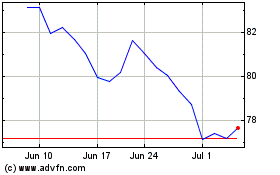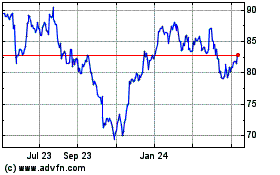New York, New York (NetworkNewsWire) – The panorama of health
care proposals paraded by Congress is just one act of a drama
unfolding behind the scenes. Mostly hidden from public view, the
industry continues a metamorphosis as it adopts Health Information
Technology (HIT) systems. HIT systems are designed to dramatically
transform the delivery of health care, making it safer, more
effective, and more efficient. And one way they are posed to do so
is by generating huge amounts of data that is more amenable to
statistical analysis. But the advent of big data also has the
potential to bring big headaches for health care providers, which
is why they are turning to companies like ORHub, Inc.
(ORHB) (ORHB
Profile), Medtronic plc (MDT), Cerner (CERN), Omnicell, Inc.
(OMCL) and McKesson (MCK) that offer
novel technological remedies.
The development of these technological remedies was catalyzed
back in 2009 after the passage of the Health Information Technology
for Economic and Clinical Health (HITECH) Act, which provided
incentives for the adoption of electronic health records (EHRs) and
supporting technology. To receive the financial incentives under
the Act, providers are required to demonstrate “meaningful use,”
which the Centers for Medicare & Medicaid Services (CMS)
defines as using certified EHR technology to improve quality,
safety, efficiency and reduce health disparities; engage patients
and families in their health care; improve care coordination; and
improve population and public health - while maintaining privacy
and security. This is a tall order, and one that health care
providers often struggle to meet.
A look at the first stage of Meaningful Use (MU) will reveal
why. MU Stage 1 has 14 Core Objectives and 10 Menu Objectives for
hospitals. The 14 Core Objectives encompass a comprehensive and
daunting list of mandates. Hospitals must introduce computerized
provider order entries (CPOEs), introduce the one clinical decision
support rule, do drug-to-drug and drug-allergy interaction checks,
record the patient’s demographic profile, maintain an up-to-date
problem list of current and active diagnoses, maintain an active
medication list, record and chart changes in vital signs, and
record the patient’s smoking status, in addition to submitting
reports to the CMS, safeguarding the information, and sharing it
with patients, on request, and other providers.
This data collation and integration remains a goal of HIT
systems such as the one offered by ORHub
(ORHB). The ORHub Software is a cloud-based
proprietary platform aiding the transformation of surgery from a
traditional approach to a value-based model.
Known as Surgical Resource Management, this software was
specifically designed for surgery management, providing
significantly enhanced capabilities compared to more traditional
EHR solutions.
The platform facilitates care providers at every stage of the
surgical process to collaborate, organize, deliver, measure and
reimburse in one intuitive, easy-to-use program. This significantly
decreases cost and improves outcomes by eliminating inefficiencies
and duplication of effort, as well as errors and omissions that
result from siloed processes in outdated software and poor handoffs
from one part of the care process to another.
ORHub’s technology is being used by two hospitals in Southern
California, and the company has plans to run three pilot programs
in other hospitals before officially launching the platform
nationwide.
Medtronic (MDT) has embraced the integration
strategy in earnest. In 2014, it acquired, for close to $43
billion, Covidien, which makes a range of patient monitoring
platforms and navigation systems. Medtronic, which produces the
smallest pacemaker on the market, continues its innovative streak.
It says its Health Informatics & Monitoring product can let
physicians “be in two places at once,” and makes this claim because
the system gives physicians the ability to remotely view vital
information from multiple device categories, including ventilators,
capnography monitors, depth of consciousness monitors,
cerebral/somatic oximeters, and pulse oximeters.
The system wirelessly transmits patient information from the
bedside to a hospital’s server. From there, clinicians can view the
data within the hospital network on any web-enabled device. Also,
thanks to wireless sensors, clinicians are able to monitor
patients’ vitals – even while away from the patient or
hospital.
Also heavily betting on integration is Cerner
(CERN), the world’s largest publicly traded pure health
information technology company with 2016 revenues of $4.8 billion.
Cerner’s Revenue Cycle Management (RCM) system brings together
clinical, financial and operational data in a way that improves
workflow and helps to control costs across both acute and
ambulatory locations. Last month, it inaugurated two new office
towers as part of its “Innovation” campus. The complex, to be
further expanded over the next 10 years, is being constructed to
look like a strand of DNA.
Omnicell (OMCL) offers IV robotic and workflow
solutions, products that automate the dispensing of medication, and
hospital supply chain management software. The company provides
services to over 4,000 health care facilities around the world and
it has about 32,000 institutional and retail pharmacy
customers.
McKesson (MCK) is a Fortune Global 500 company
that has identified the four major big data health care challenges
as the deluge of digital data, not enough data scientists, the
limitations of existing EHR systems, and institutional resistance
to change. To deal with these challenges it is offering its
McKesson Analytics Explorer, which uses visualization to help users
analyze data. The company sees this approach as a way to make
advanced statistical techniques available to those without
mathematical training.
ORhub is joining the ranks of these leaders with its SaaS
platform, which has already been implemented in two major hospitals
in California.
For more information on ORHub, Inc. please visit: ORHub, Inc.
(ORHB) & www.ORHub.com
About NetworkNewsWire
NetworkNewsWire (NNW) provides news aggregation and syndication,
enhanced press release services and a full array of social
communication solutions. As a multifaceted financial news and
distribution company with an extensive team of contributing
journalists and writers, NNW is uniquely positioned to best serve
private and public companies that desire to reach a wide audience
of investors, consumers, journalists and the general public. NNW
has an ever-growing distribution network of more than 5,000 key
syndication outlets across the country. By cutting through the
overload of information in today’s market, NNW brings its clients
unparalleled visibility, recognition and brand awareness. NNW is
where news, content and information converge.
Please see full disclaimers on the NetworkNewsWire website
applicable to all content provided by NNW, wherever published or
re-published: http://NNW.fm/Disclaimer
Source:
NetworkNewsWire
Contact:
NetworkNewsWire (NNW)
New York, New York
www.NetworkNewsWire.com
212.418.1217 Office
Editor@NetworkNewsWire.com
Medtronic (NYSE:MDT)
Historical Stock Chart
From Mar 2024 to Apr 2024

Medtronic (NYSE:MDT)
Historical Stock Chart
From Apr 2023 to Apr 2024
